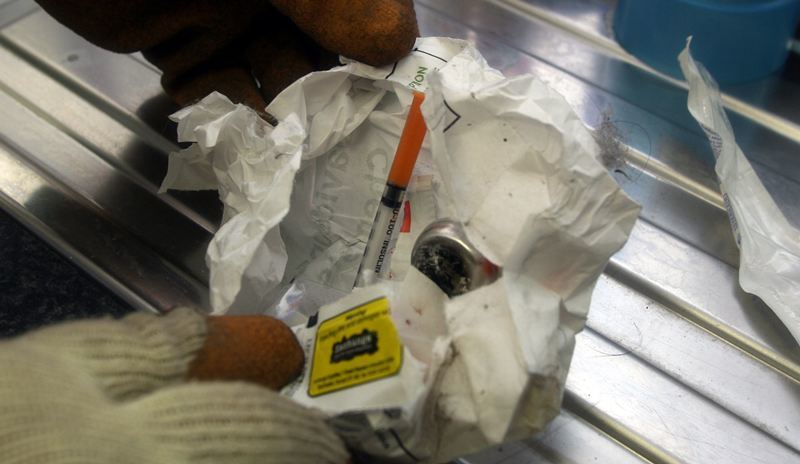Early intervention is the key to tackling Scotland’s drug death toll, according to community safety minister Fergus Ewing.
More than one-third of Scots who died from drug-related deaths in 2009 had not received any treatment for their addiction, according to a report published yesterday.
The report, which analysed 432 deaths from overdoses, revealed 172 of those users had had no contact with treatment services during their lives.
The majority of those who died were male, white and from a deprived area. Most had been drug users for at least five years, with heroin the most widely used substance.
The deaths were studied in a report by the National Drug Related Death Database (NDRDD), published by the Information Services Division (ISD) of NHS Scotland.
Mr Ewing spoke out ahead of a meeting with Fife Alcohol and Drug Partnership in Glenrothes, which coincided with the release of the statistics.
The minister said the detail contained in the ISD report, which he described as “distressing reading,” would assist services in intervention and help save lives.
He said, “This report makes very difficult and distressing reading. I would like first of all to express my sincere sympathies to everyone who has lost a loved one to drugs.
“While the overall number of drug deaths published last year reinforced the challenge we face nationally, these statistics provide us with a detailed description of the men and women whose tragic deaths comprise the overall number, and provides a snapshot into each of their circumstances and lifestyles prior to their death.
“We can see, for example, that over a third of those who died had no record of any contact with a drug treatment service at any point in their life. Earlier intervention through treatment may have been able to steer these people away from addiction and into recovery.”Death rateIn 2009, 545 deaths related to drug use were recorded in Scotland. Dundee had the highest death rate per head of population greater than Glasgow City with 0.2 deaths per 1000 residents. A total of 28 Dundee drug users lost their lives in 2009.
Angus, meanwhile, was just above the Scottish average of 0.08 drug deaths per 1000 population at 0.09 a total of 10 deaths.
Fife was just below the average at 0.07, 24 deaths, and Perth and Kinross was well below with three deaths during 2009, a rate of 0.02.
Mr Ewing said the government had increased the amount of funding for front-line drug services by over 20% since 2006-07, and introduced a target of 90% of drug users being treated within three weeks by March 2013. At the moment, 87% are being treated within four weeks.
He added, “The Scottish Government believes that our national drugs strategy, The Road To Recovery, will make the difference. It provides the framework for changing our approach to tackling problem drug use and preventing drug related deaths through a focus on recovery.
“Every death from drugs in Scotland is a tragedy. However, we cannot turn the clock back. Everyone with an interest in fighting drug misuse this government, front line addiction workers, GPs, social workers and others can learn something from this report today and its findings can help all of us, not least vulnerable members of society currently experiencing a drug misuse problem who we can still pull back from the brink.”
Dr Roy Robertson, who chairs the National Forum on Drug-Related Deaths, said, “Establishing this national drug related deaths database is a priority for Scotland because of our particularly worrying drug problem and associated mortality.
“Along with the annual figures from the General Registry Office, this database will provide great detail on the circumstances and possibly precipitating causes of deaths related to drugs in Scotland.
“Understanding the full implications of the key findings of this report and the opportunities these present will take some time and the full advantage of this database will increase year by year when trends become apparent. New insights supplied through interrogating the database will be important for front line clinicians, for treatment services and for policy direction.”TreatmentNHS Tayside has said it is working to improve access to drug treatment services after it emerged Dundee has the highest rate of drug-related deaths in the country.
Dr Kirsty Licence, consultant in public health medicine for NHS Tayside said the health board is working to improve access to drug treatment services.
“The number of drugs deaths in Tayside and especially Dundee City is a matter of great concern to all the partners involved in this area of work,” she said.
“There is a multi-disciplinary Tayside-wide group that looks at the actions required in responding to drugs deaths and they make recommendations to the three Tayside Alcohol and Drugs Partnerships.
“The Tayside Substance Misuse Service is implementing a plan of action to further improve access to drug treatments services. We have also been working to increase access to overdose awareness and response training for relevant staff.”
Gareth Balmer from Dundee drugs charity Addaction said, “We are all working together in Tayside to try to reduce waiting lists for treatment.
“The majority of deaths are people not accessing treatment so we would encourage users to seek treatment as soon as possible.”
Scotland’s shadow community safety minister, MSP James Kelly, accused the SNP of not making the most of Drug Treatment and Testing Orders (DTTOs).
“DTTOs have proven to be a robust and effective approach in tackling drug misuse but the SNP government have been slow to expand their use. Labour believes that greater use of such orders could be a positive measure in the fight against drug misuse.
